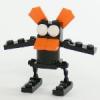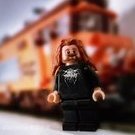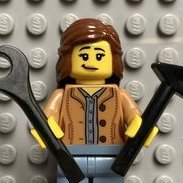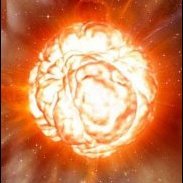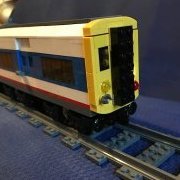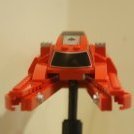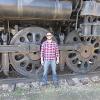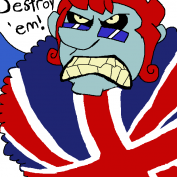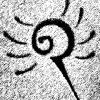Search the Community
Showing results for tags 'diesel'.
Found 78 results
-
Using the LEGO standard gauge I built the same diesel engine as shown in a previous post with a different scale. It's the V-52 of the Deutsche Bundesbahn - running in the 1960s between Mosbach and Mudau. LEGO standard gauge is almost 40mm (5studs). The real train ran on 1000m, so I chose a scale of 1/25 - one stud is 20cm, 5 studs is 1m. The engine is 12wide and approx 50 studs long. It's powered by 2 XL Power Functions motors and remote controlled by a BuWizz. It's designed for standard LEGO gauge, but can only handle R72 (and greater) curves. To run smoothly additional weight is needed (metal spare parts from shelves) - it weighs 1.7kg. (It was my entry for the Brick Train Awards - "Best Other Locomotive" in Europe)
- 14 replies
-
- narrow gauge
- moc
-
(and 1 more)
Tagged with:
-
Hi, 10 years ago I made this with some left-overs: I Improve some skills and Lego also made a lot of new parts, so I remade from scratch this locomotive: 7wide, 50studs long, 2L PF motors, and the fan on top spins when it runs. This is a render, I don't have enough parts yet to build in real life. Hope you like it.
- 9 replies
-
- cp1960
- bombardier
-
(and 2 more)
Tagged with:
-
One of the biggest issues I find with building in 6 wide is hiding PF/PUP elements, especially when I want to have walkways down the side of the locomotive. A few years back, I started on a locomotive design to put the battery pack partially below the base, between the two sets of wheels. I never finished this design, so when I wanted to create a switcher a few days back, I thought of this old design (as I didn't want the loco to end up being huge to conceal the battery box and end up looking bloated). This is what I came up with. The engine is essentially symmetrical front to back, so it is meant for going in and out of sidings all day in a yard. The cab comes off in one assembly below the 1x1 cheese slopes. Inside, there is a seat that is directly on top of the PUP box, so easy access for power/linking. Unlike some of my other models, I did not make space for a PF receiver so it can only be powered by PUP or 9V. I felt this was ok though, as I really wanted the electrical components to not dictate the shape of the engine too much. I have never tried putting the battery box in this location and since it is not above the powered wheels, traction may be a problem? There should be enough open space to put a ballast brick in above the wheels, should there be any issues. Overall, I'm pretty happy with this MOC. I feel the cab looks off in the side view, but other than that, I think it turned out nicely. As usual, there is a download for the Studio file. From now on though, I will just be putting all of my files into one folder so any links on my posts will grant you access to all my models. Thanks for reading! File Download: https://bricksafe.com/pages/Legownz/legownzs-train-mocs
-
Sharknose diesel units + 4-8-4 steam engine with Meramec River Runner passenger train
Murdoch17 posted a topic in LEGO Train Tech
The whole Merrimac River Runner passenger train, headed up by Baldwin RF-16 "shark-nose" A +B diesels number 3701 with assistance provided by 4-8-4 "Northern" steam engine number 2980. The name of this train is a play off the Missouri River Runner, a real train that Amtrak runs from Kansas City to St. Louis. The Meramec River is a body of water that runs next to the real world 12-inch gauge Wabash Frisco & Pacific, so I switched the name to the Meramec River Runner. Never mind the fact the Missouri Pacific used to run on the roadbed the WFP now uses up from the 1850's until about the 1940's, when it was rerouted to it's current alignment and abandoned the old one to the eventual WFP use from the late '50's to today. These Baldwin diesel RF-16-like locos were inspired by set 10020, (Santa Fe Super Chief) for most of the basic body work and and fellow Eurobricks user @Legownz for the knife-like Sharknose front end. (Thank you for that ingenious design!) The cab and booster units feature no interior details because I have no need for such items on my layout.. that and retrofitting all my trains with inside details would be quite costly. The rear of each of the locos feature doorways to the next engine compartment, and / or the passenger train itself. This 7-wide steam loco began life as a 2-8-4 Berkshire type built by @Plastic_Goth and purchased from Rebrickable a seen here. I upped the wheel count by another leading axle, making it into a 4-8-4 Northern-type from the original 2-8-4 Berkshire. The pistons are entirely my own work, as is the complete tender. The coal tender will have the letters WFP on the side, standing for Wabash Frisco & Pacific, while the cab will feature the number 2980 on both sides. This is a scrambled homage to real world WFP 4-8-2 engine 928, which is so strong, it's pulled every piece of rolling stock the railroad owns -at one time- with ease! The inside of the cab features two gauges and the firebox door. This is all the interior the whole train features. Combination baggage and passenger car three identical passenger coaches for the train The observation car of the Meramec River Runner. (This car is to become fully enclosed soon, with a wraparound rear window provided by two of this piece.) Any thoughts, comments, or complaints? EDIT 5/11/21: Added 4-8-4 steam loco to this post. Real life pictures coming soon. -
This is my first post that I was so confused about which theme I should post in: train? technic? scale modeling? I finally choose train tech just because it's a train after all If I made a mistake that put it in the wrong place, please forgive me. Actually I created a MOC train that is a 1:35 scale model and also with technic internal though it looks like ordinary stud-built. It's a model but not only looks look. It should be able to do something like the real one. 1, Origin It won't be happy if a man never creates something. Since my kid likes train toys very much, I start to focus on rail transportation. I found Lego's official sets are quite compromised since they need to match the mass need. The traditional scale train models are normally small and very expensive which is also hard to get in China especially one delicate like Marklin(okay, it's because of the price). We are AFOL, so I must have a scale train model, not a toy. 2, about type Targeting train is also in very straightforward logic. I am ready to build "Dora" (Heavy Gustav) as the showdown to my kid. I will tell him nothing is necessarily built on the rail after completion of this ultimate rail machine of all the time in history. Heavy Gustav cannot move by itself, I need locomotives. yes, before any creation on the rail, the locomotive is the prerequisite. That would be very clear, D311 diesel-electric locomotive was specialized built for "Dora" by Krupp. Two groups of double D311 drive "Dora" to move with each on two four-axis chassis. pic1: D311/V188 in WWII D311 WWII by Nash Liu, on Flickr 3, Scale It is a scale model that also needs to run on standard 9V track. The scale bases on the gauge of track known as L-gauge scale that is between 1 and O gauges. I choose 1:35 because there are the most resources of 1:35 Military models When TAMIYA continually push this scale. pic2: a scratch build D311 static model with 1/35 Scratch Build 1/35 D311 Model by Nash Liu, on Flickr 3, Exterior The ordinary stud brick build is always more graceful and beautiful showing than technic build. There is no weird gap and abstract design like technic exterior. However, the stud brick is not flexible to show various details and often takes up a lot of space. SOT can show as one stud, but SNOT often has to spend 2 studs to show different details. If Lego develops more special bricks and plates for combination and detail showing, the precision of the Lego model will be up to another level. Maybe Lego's official target is only toy. pic3: what this lego train model looks like(I don't have enough unicolor bricks, so I post computer rendering graph) MOC D311 Diesel Electric Locomotive 1:35 Exterior by Nash Liu,on Flickr 4, Interior Beside exterior, the model is ensouled by the functions that should be capable like its true body. D311 is the most powerful locomotive at that time, so the model also should be the most powerful train in the lego universe. pic4: super compact technic design with 4 motors that are parts of load-bearing MOC D311 Diesel Electric Locomotive 1:35 Interior by Nash Liu, on Flickr 5, Extreme Design What is an extreme design? Simply speaking, it is not a waste of one stud. Designers are very likely to MOC without limits. We can often find super complex and magnificent masterpieces on the web. But the model should have confine, at least confined by scales and functions. From the above, I list the following features. 1, Dual XL motors 2, Dual stepper motors for clutch and gearbox 3, Dual 8881 battery boxes that contain 12 AA batteries for the enormous duration 4, 2-speed gearbox 5, differential adder for XLs coupling 6, clutch between 8x8 and 8x4 driven 7, bogie integrated driven system pic5: a prototype that shows adder, XLs, steppers, and general structures Prototype PowerFunction D311 by Nash Liu, on Flickr 6, work with its couple The ultimate Gustav is still a blueprint in my brain. Many guys including me are curious that what they look like when Gustav is moving in history. I build GCs and PS with an appropriate scale. the model of Gustav is 1:72 normal design. I scale down D311 to match 1:35 by PS(Sorry, who can tell me which CAD can change design size by scale?) I CANNOT wait to build 1:35 with extreme design. Although the specification is not clear yet, one thing I can make sure and a super exciting feature is how to make this giant millipede turn on Lego standard track. It should be very magnificent. Heavy Gustav with 4 D311 by Nash Liu, on Flickr
- 26 replies
-
I never bought the maersk train. But after watching one tootle around our club layout I was inspired to see if I could build one from what I had. It was never going to be blue and grey, but having the panels in red lead me to that colour. Here is an progress shot, one element type needs replacing with the correct colour, otherwise it’s ready to roll. And of course, it stiill needs lettering and numbering. Any tips on that would be appreciated. And yes. I’m aware the GP-40-2 never had a high nose variant and the SD-40-2, which did, properly had Co trucks. Perhaps I should splurge on some of zephyr’s truck frames...
-
The Stadler Euro (known as the Vossloh Euro until 2015) is a class of diesel-electric locomotives built by Stadler Rail for the European market. It is available in two basic variants, the four-axle Euro 3000, and the six-axle Euro 4000. These locomotives are powered by EMD710 Engines This particular model is my interpertation/atempt of E5033 Series, since "Cp Carga" change to "Medway" this was the first Locomotive who reveal the new color scheme, Medway baptize the locomotives with girls names, this one is "Matilde" Is powered by 2 L Motors, i try to make the top fans spin, connect some how to the gears, but after several hours I quit that idea. This was make on LDD, improved on Stud.io, the decals made with PartDesign. 7wide, 1256 parts, 48studs long.
-
Hello, I have been mostly lurking and occasionally posting here for a while. I though it’s about time to share a MOC or three and this is the first. The prototype is the long serving small/medium BR Class 20 in BR Blue - a common sight for most of the last 60 years on railways across the uk: https://en.m.wikipedia.org/wiki/British_Rail_Class_20 In terms of background, I set myself some limitations before I started building trains: 1. 6 wide core build 2. A Lego model based on a real train but not a scale model per-say. 3. No Bricklink etc purchases - parts on hand only. 4. Doors must open! Finally, they had to be sturdy enough to be played with by my children without to many issues: Its first run out was round the office Christmas tree (I’m up to date with the photos as you can see!) pulling a wip MOC BR Mk1 carriage in Hogwarts colours and a “festive” train of sweets (hence twin motors and polarity switch hidden in the cab). The next stage is decals for the side panels and a splitter for the lights so I can have three point lighting through the headboard boards. Comments and alternate versions very welcome, I know there are a couple of other versions of this type out there but there doesn’t seem to be much information on them.
- 3 replies
-
- diesel
- british rail
-
(and 1 more)
Tagged with:
-
Thomas the Tank Engine - MOCs of locomotives and rolling stock
Murdoch17 posted a topic in LEGO Train Tech
Builders note on the following models: These engines were my most beloved thing to watch in childhood up until the Polar Express movie came out to displace it in 2004. I loved to play with my wooden railway models, and would have thought I'd have died and gone to heaven if I'd had the Lego models described below when I was little, around the time the movie came out when I was 6 or 7 in 2000 / 2001. So, in short, look on, younger Murdoch17 and gasp at what you've been able to accomplish with the help of many others and quite a few years of knowledge and learning. I still am a passive Thomas fan, BTW, (my collection of books is still around somewhere!) but everything after the switch from the models to CGI turns me off., so I haven't watched the show in 10 years, just in case anyone is wondering. Oh, and the Polar Express models by @SavaTheAggie were what inspired me to get this serious into LEGO trains in 2011 or so, so I've come full circle - from Thomas to Polar Express from the movies, then from Polar Express and back to Thomas the long way round via LEGO. LADY the magic engine + coaches Here is Lady the steam loco and her train consisting of two (custom) coaches Victoria and Elton, driven by Burnett Stone and Mrs Conductor. They travel between the worlds of Sodor, our world (circa the year 2000), and many other rail-gateways, to bring the vital magic gold-dust, paying passengers and small amounts of cargo to their respective destinations in the multiverse. It's a difficult and dangerous job (especially with Diesel 10 on the prowl) , but somebody's gotta do it. This model was originally Hunter Dobbs steam locomotive and is based off of "Lady" from Thomas And the Magic Railroad (you know, the 2000 Thomas And Friends film that sadly, flopped horribly.) I redid the boiler using @ScotNick design from the BR Class 9F 2-10-0. Here is a link to Hunterdobbs' original engine. Fictional background (from Thomas and friends wiki) for this engine, as seen in the Magic Railroad movie. (Also, the figure in the cab of the engine is a representation of Burnett Stone, caretaker and driver of Lady, as played by Peter Fonda in the 2000 movie.) Lady once came to the Island of Sodor a long time ago, when she was found by Diesel 10, an evil diesel engine who wanted to destroy her. Lady and Burnett Stone both ran away from Diesel 10, but during the chase, Burnett used up all her coal and made her go too fast, causing Diesel 10 to catch up and crash her. Lady was taken back to Muffle Mountain and stored inside Burnett's workshop, where he spent years desperately trying to restore her to working order, but he did not have the right coal to make her steam. Years later, Lady was still out of service, and without her, the Magic Railroad began to lose its magic. That all changed when Lily, Burnett's granddaughter, and Thomas brought a truck of coal from Sodor to Muffle Mountain, which proved to be the correct coal necessary to make her steam. Lady came back to life and returned to Sodor, where she was once again chased by Diesel 10. Lady, Burnett and Thomas successfully managed to escape Diesel 10, and she gave the Conductor Family the Gold Dust they needed. As a side note, while watching Thomas and the Magic Railroad as a kid back in the early 2000's, I always wondered how it was supposed to be a technical railroad if Lady (the magic steam engine who powered and ran the warp-gate railway) had no coaches for people to sit in. She had a station on Sodor, and one on in the real world in the form of her owner's workshop, (as explained in the movie) but where were the coaches she most likely used to deposit people at these points? Well, now there are two brand-new coaches ready for service! The rear of the loco, with the red headlamp. These cars have been named Victoria and Elton. These names were chosen for several reasons, but mostly for these facts: Victoria was because of when Lady was supposedly built (in the 1890's) in "Thomas and Friends" canon and that is who was Queen at that time. Elton because I was listening to a good Elton John song ("This train don't stop here anymore") and decided then and there he was going to model the second car. So, we have a stuffy, quiet-loving type coach of the late 1800's, and a flamboyant, lovable, with a passion for singing out load coach from the 1890's, but with the heart and soul of Elton John. Oh, and they are both painted bright magenta to match Lady, who is still driven by Burnett Stone, but conducted by a female version of the Mr. Conductor character from the Magic Railroad film. Burnett Stone (Played by Peter Fonda in the 2000 movie) and Mrs Conductor (played by a actress as yet unknown... fill in your favorite one!) DIESEL 10 the antagonist of the Magic Railway film This 6 wide "Warship" (also known as BR class 42) with hydraulic claw (AKA Diesel 10) has been heavily inspired by KaijuBuildz and his Diesel 10 model to have a completely new design compared to my older inaccurate model. I did this by looking at two or three pictures of his model and reverse engineering it except for the frame and main windows. (The front / rear windows were changed as I couldn't figure them out, and the frame because I wanted to make sure he could pull trains.) As you can see, I chose to leave off the face to keep the engine more in line with the rest of my locomotives. You can see @KaijuBuildz Diesel 10 MOC here in his Flickr photostream. The rear of the locomotive. This in-universe background info is from the Thomas and friends wiki and concerns the events of The Magic Railroad movie (though he is still in the TV show until ~2017, unlike his opposite number, Lady the magic steam engine): Diesel 10 once visited the Island of Sodor a long time ago, and caused trouble for the steam engines while he was there. During his visit, he found Lady, the engine responsible for keeping Sodor alive, and chased her, making her crash. Following the accident, Lady's caretaker, Burnett Stone, hid Lady in his workshop and tried to restore her, but failed to bring her back up to steam. Several years later, Diesel 10 came back to Sodor when the Fat Controller was on holiday, intending to destroy Lady forever. He was first seen by Thomas and Gordon when he raced past them at Killaban Station, and brought his two lapdogs, Splatter and Dodge, to the railway, who were present when he was scheming. He caused several problems for the steam engines, such as dumping sneezing powder around Tidmouth Sheds and later destroying the scaffolding that had been placed beside the shed. When Mr. Conductor travelled across Sodor to find the windmill, Diesel 10 found him and held him over the Big Dipper viaduct, intending to drop him. However, Mr. Conductor managed to escape by cutting one of the hydraulics hoses to his claw with a pair of wire cutters, causing him to fling Mr. Conductor across the island and to the windmill. Diesel 10 was later present at the Coaling Plant, where he was covered in coal when he was teaching Splatter and Dodge “how to stop being stupid”. After Junior flew in the air after riding the windmill's sails, he landed on Diesel 10's cab, who raced across the island and to the smelter's yard, where he tried to push James and Junior into the melting pit. Fortunately, Junior and James managed to escape by using the last of the former's gold dust. After Lady was brought back up into steam and returned to Sodor, Diesel 10 found her and began to chase her, Thomas and Burnett across the island, until they reached the viaduct, but not before Splatter and Dodge betrayed him. Lady, Burnett and Thomas managed to cross the viaduct safely while it was collapsing, but it had already done so by the time Diesel 10 came over it and he plunged into a barge of sludge below the bridge, and was sent away in disgrace. THOMAS the tank engine + coaches My newly revised Thomas is based off these instructions from Block Junction, albeit in heavily modified form. Thomas' two coaches Annie and Clarabel are my own design, and were built almost totally from my own parts collection - only wheels and buffers were purchased for them. The front of Thomas is lacking a face, but I'm not concerned about that... I says he's sleeping when kids ask at trains shows. The rear of the famous tank engine. There is a bit more inside printed details this time for his cab controls. The car on the left (Clarabel) is mostly passenger seating in the front three-quarters, with the guards compartment (and luggage storage) in the rear-most section. The other coach (Annie) is meant for passenger seating only. PERCY the small engine This rendition of Percy, the 0-4-0 saddle tank steamer from the Railway Series books and Thomas and Friends TV show was heavily inspired by the Lgauge website's Percy model (as seen here) However, I added Big Ben Bricks green medium wheels to make it stand out, plus working pistons whereas the original had only 9v powered wheels and no real pistons. Rear view, with the cab controls visible. As for cars for Percy to pull, I have two mail cars already built from late last year. MURDOCH the heavy goods engine I originally built the model in late 2013 based off this unfinished 9F Murdoch model by @ScotNick. It was uploaded on Brickshelf first, and later on Flickr after I uploaded my copy (LDD only, at first) in November 2013. When I had redesigned the engine to build it IRL, I realized orange had virtually been eliminated as a color choice at that time. Windows were (up until that summer when CITY Arctic dropped) only from the 2004 BNSF loco, and orange was VERY expensive as a color. It was impossible in the correct color. Orange's pallet of parts would increase in the intervening 8 years, culminating in 2022 with every orange part I needed being buyable! The rear of the tender with the number 17 on it. A view inside the cab. JAMES the mixed traffic engine + branch line coaches I used the instructions of set 76423 (Hogwarts Express and Hogsmeade Station) and modified it a bit to turn it into James the mixed traffic engine from The Railway Series! I removed the pistons, changed the funnel / dome, added side rods + magnetic couplers, revised the front bogie into a pony truck, and I even made enough room for a mini-figure to stand in the cab! The only things missing I can't replicate are a pair of leather bootlaces... The inside of James' cab. These four coaches are for use with James the mixed traffic engine. The four coaches seen above are based off Thomas' carriages Annie and Clarabel, but in a different color (these in tan vs. their reddish brown) to keep those two special. I also added a curved tumblehome to these new carriages as well. The three regular coaches. The guard coach, with the space for the guard / conductor at the rear-most compartment. DIESEL the original antagonist The BR class 08 diesel switcher you see here is based off a @Chromeknight design from way back in 2011-ish. It features a sliding center axle to get the three wheels to clear curves and switches, and is built in British Railways unlined black. The loco is supposed to represent The Evil Diesel as seen in Thomas and Friends TV show / The Railway Series books. (The less said about the travesty known as All Engines Go, the better!) The rear of the locomotive. I hope he's learned his lesson since the last time has was on Sodor! (Spoiler: he hasn't) HENRY the green engine To create Henry in his latter form from the Thomas and Friends TV show / The Railway Series books, I took set 76423 (Hogwarts Express and Hogsmeade Station) and modified it quite a bit. I revised the boiler design, added two plates to the cab height, devised working pistons, up-sized the front bogies' wheels, and changed around the tender a tiny amount. Here we see Henry with his driver (on left) and fireman. (on right) The rear of the tender. Inside of Henry's cab. GORDON the big engine + express coaches For the third and final time, I have taken set 76423 (Hogwarts Express and Hogsmeade Station) and modified the engine portion quite a bit. This time I stretched it out into a 4-6-2, specifically Gordon from the Thomas and Friends TV show / The Railway Series books. In fact, I changed so much, that there isn't much of the original set left! The rear of the loco. The completed express train. These four regular coaches (alongside the Guard coach seen in another picture) are inspired by the 2019 Hogwarts Express cars, but without interior or removable roof / walls. I based the colors of the coaches on a inverted set 10194 (Emerald Night) coach color scheme. I always thought the colors looked better like this, and it avoids the problems of the tan 1 x 4 x 3 train windows used in the original set. (which are very expensive!!) EDWARD the kind old engine The one that started it all! This inside-connected 4-4-0 was designed by taking parts of set 7597 (Western Train Chase) and combining them with a tender originally designed for certain other English loco. The resulting amalgamation is supposed to be Edward from The Railway Series books / Thomas and Friends TV show. Rear view. EDIT 4/13/24: Edward in the real world added! Have any Thoughts, Comments, or Questions? All are welcome here! -
Hi everyone! This is my first MOC post, and second post to Eurobricks after my welcome post. I was inspired to make this train from an image on Google of a "CRRC Dalian CKD7B" Chinese locomotive. Apparently these were designed specifically for use in Myanmar, and are very difficult to find any photos of them in the wild! As said in the title, this was inspired by the locomotive- the proportions are a little off! I'm glad with how it came out. Original: http://www.dloco.com/LISTS/product/_MAINPAGE/EProducts/default3.aspx?id=1118 Glad to hear thoughts and comments! Matt
-
I recently rebuilt my GP-9 to resolve some aspects of it that I was unhappy about. Here's the final result: New Haven GP-9 Rebuild by Matt Csenge, on Flickr Primarily, I rebuilt it so that the section around the battery box and IR receiver is truly 5-studs wide. After that, I added the fuel ports to the sides of the fuel tank. Then, being inspired by Aaron Burnett's amazing Central of Georgia GP-9, I modified the ends using less-than-half-stud offsets to get rid of the stepped slope typically seen when using cheese slopes. I also added lights using Brickstuff's new Power Functions Power Source v2, which includes directional lights. Unfortunately when I moved back to NY I misplaced my controller, so I haven't tested it yet... Stickers from OK Brick Works and Jim Pirzyk. New Haven GP-9 Rebuild by Matt Csenge, on Flickr New Haven GP-9 Rebuild by Matt Csenge, on Flickr And here's the pre-rebuild version: NYNH&H GP-9 by Matt Csenge, on Flickr
- 10 replies
-
- locomotive
- moc
-
(and 1 more)
Tagged with:
-
I made a small Diesel Shunter in LDD, and it looks good! Front view Back view Side View Cab view. Now why don't Lego do sets like this?
-
CB&Q Pioneer Zephyr streamlined diesel train-set - updated 12/08/23
Murdoch17 posted a topic in LEGO Train Tech
The Chicago, Burlington & Quincy (CB&Q) Pioneer Zephyr was the first successful American stream-liner, and made a record-breaking speed run from Denver to Chicago on May 26th, 1934. It arrived 1 hour and 55 minutes ahead of schedule with a total run time of 13 hours and 5 minutes... Note, the run time of a regular steam train pulled across the same distance in about 25 hours at much slower speed than the 77 MPH average of the Zephyr on this non-stop run. (It even reached a top speed of 112 MPH at one point during the trip!) This event was even featured in a heavily fictionalized Hollywood block-buster movie, "The Silver Streak" (The original 1936 drama, not the 1970's comedy of the same name) which also featured many scenes of and on the train. This train even started it's own Zephyr-mania, with everything from Ford cars to sports-teams having "Zephyr" slapped on the name to capitalize on it's considerable fame. The Pioneer Zephyr consist was eventually donated to the Museum of Science and Industry in Chicago, Illinois on the 26th anniversary of the Denver-Chicago speed run. From 1960 until 1994 it was stored outside, but since then it is now indoors in the basement of the museum near the parking garage. As such, it will never turn a wheel again. (picture coming eventually) The rear car features a wraparound back window. (It isn't pretty, but it is the best I can do.) (picture coming eventually) The Lego model and the real train feature four joined cars, with the power car / RPO area up front, (RPO is short for Railway Post Office) baggage and coach in the next car, then another coach, and finally the observation lounge at the rear. The third car (the coach) was added in 1938, and even though it isn't original to the train and is not on display with the rest of the Pioneer Zephyr in Chicago, it carried the car for most of it's operational life, thus it was added onto my MOC. Comments, Questions & Complaints are always welcome! Thoughts? NOTE: Main post edited 12/8/23 - one real life photo added to this post, the other two didn't turn out... will retake them when time allows. Sorry! -
"I've been working on the railroad, all the live-long day!" This train consists of a ALCO diesel locomotive (specifically a RSD-12 type) and six cars: - a (working!) crane car - depressed-center rail wagon - a (working!) ballast hopper - tool / worker bunk car - weed killer tanker - wide-vision bay-window caboose. The train model features several neat printed pieces found in several Juniors sets and and seven generic track workers. (as seen below) ...while the roadbed crew consists of: -Bucket-lift truck from set 3179 (Repair truck) -Dump Truck from set 7789 (Lotso's dump truck) Drill vehicle MOD from 7936 (level crossing) Front end-loader from set 7630 (front end-loader) ...and a official's inspection car MOC - not yet built This model was originally a ALCO MRS-1 built by Anthony Sava, but has been so severely modified that it no longer looks like the prototype loco. So I went searching And found another ALCO locomotive, a RSD-12 that looks like my loco. Both my model and the prototype have the six wheels, and the same basic hood and cab design. The long hood of the loco has been designated the rear with a double red light. (no picture taken yet of this car) This car is not your ordinary tanker car - it contains weed killer for use on the ballast the train lays down. This stream crane model was heavily inspired by Whoward69's instructions for a set of crane and match truck train cars. I modified the original model seen here. I originally meant for the crane to have ropes to move the boom, but it got confusing on which rope went where so for now it's moved by the H.O.G. (Hand Of God) method. The crane can spin around in 360 degrees and lift anywhere up to 90 degrees straight up. (Their is a double set of pins keeping the boom from going too low, as well.) Here we see how the crane is hooked up to the depressed center flatcar most of the time. The heavy-duty depressed-center wagon has brick-built arms to secure the cargo of railroad track in place. This model was inspired by a coal hopper on an older website called LGauge .com. I tunrned the old finger hinges into new pin-orientated ones and colored the car yellow to match the MOW paint scheme. The hopper's bottom door open and can dump 1 x 1 round plates / bricks onto the tracks for ballast. (no picture taken yet of this car) This is the workers tool car. In reality it's empty, but it's supposed to have rows of racks for tools, and a special box for broken tools to be fixed when they get back to the division HQ. The caboose features two ladders (one per side) and more of those fancy printed 2 x 4 tiles. This is where the job site foreman has a little office. The med kit is also located here. This is the headquarters for my Maintenance of Way operations for Brick Railway Systems. I was inspired by set 60009 (Helicopter Arrest) from 2013 for most of the building, while most of the inside details came from set 10027 (Train Engine Shed) in 2003 a whole ten years before the other set was even produced. As for the billboard on the roof, I borrowed the letter's design from my brother's model (with his permission), and put them on a billboard to spell out OCTAN. The tracks on the side of the building are for my ALCO RSD-12 and it's accompanying six car work train to sit and await their next task. The inside on the lower floor is furnished with a lathe, drill press, fire extinguisher, oil drum, and a vise. The upper floor (the break room) has a table, a few chairs, coffee machine (with paper cups!), fireplace, and a recycle bin. I will be updating this with the two missing pictures soon. As for the digital items, I will built them as funding allows. As usual, Comments, Questions and Complaints are always welcome!!
-
British Rail (BR) class 38 diesel locomotive - 7939 / 60098 inspired MOC
Murdoch17 posted a topic in LEGO Train Tech
The BR class 38 seen here is a one-off prototype. Engine number 7939 was made in 1989 to compare a Metro-Cammell made class 38 to a Brush Traction built class 60. The class 60 won the contract, and subsequently Metro-Cammell was sold and closed. The single class 38 soldiered on until 1997, when British Railways was fully privatized. The engine was then sold with a number of spare parts to Lego Rail Transportation Society, which has kept the engine running ever since as unit 7940. In the real world, the class 38 was never built. It was proposed and then dropped in favor of the class 60, which is what I based the story on. Metro Cammell really existed and was dismantled in 1989 sometime after loosing out to Brush Traction for the class 60 contract, and everyone knows that British Railways was taken apart in the mid-1990's. This LEGO model is a mash-up of a William Howard's diesel locomotives and the official Lego sets 7939 and 60098, with a set of Anthony Sava-derived three wheel sliding bogies. The rear of the bidirectional loco. The numbers "7940" go on printed 1 x 1 tiles on the sides while "LRTS" goes on the front and rear ends. The color scheme for this model was inspired by the British Rail Class D16/1 (also known as LMS engines 10000 and 10001), the first two mainline diesel locomotives in Great Britain. (see here for more on them.) Both ends of the locomotive have a engineer's cab that opens up to seat a figure at the controls, just like sets 7939 and 60098. (I just noticed there is one letter spot too few on the ends of the loco for the railways name as seen in the pictures, as there should be four studs, not the three shown) Bricksafe LDD file link: BR class 38 file Comments, Questions, and Complaints are always welcome! -
ALCO diesel RSD-12 loco (6 wide) train MOC - real world build
Murdoch17 posted a topic in LEGO Train Tech
This model was originally a ALCO MRS-1 built by Anthony Sava, but has been so severely modified that it no longer looks like the prototype loco. So I went searching And found another ALCO locomotive, a RSD-12 that looks like my loco. Both my model and the prototype have the six wheels, and the same basic hood and cab design, plus the curved ends match the RSD-12 better than the sharp-ended MRS-1. ..and here is my Lego model of it, as Brick Railway Systems loco number 7924. I even thought about putting two of this part under the headlights at both ends, but I think the model looks better the way it is now. NOTE: The printed letter tiles with the railroad's initials "BRS" will go on the long hood. I misplaced the two letter "R" tiles, and need to order some more, but the rest of the letters are on my desk. (They are hard to keep from rotating without the middle letters to hold the others in place, so they are not on the model yet.) The center axles on these six-wheel bogies slide left and right to allow for tight turns on switches and flex-track. I took Anthony Sava's original design and beefed it up, making it a lot stronger and a little taller. Here is the picture (not mine) I found that matched my model. I also believe this is the last ALCO RSD-12 left. (I could be wrong, though.) The photo is originally from here. Here is the LDD file for the diesel loco as shown above. Comments, Questions, Suggestions, and Complaints are always welcome! -
This engine is modeled after the GE 44 ton switcher locomotive. Why 44 tons, you may ask? I give you the answer from the Wikipedia article on this loco type: This locomotive's specific 44-short ton weight was directly related to one of the efficiencies the new diesel locomotives offered compared to their steam counterparts: reduced labor intensity. In the 1940s, the steam to diesel transition was in its infancy in North America, and railroad unions were trying to protect the locomotive fireman jobs that were redundant with diesel units. One measure taken to this end was the 1937 so-called "90,000 Pound Rule" :[citation needed] a stipulation that locomotives weighing 90,000 pounds (41,000 kg) – 45 short tons – or more required a fireman in addition to an engineer on common carrier railroads. Industrial and military railroads had no such stipulation. The 44-ton locomotive was born to skirt this requirement. The loco is bi-directional, and doesn't have much to differentiate between the "front" or "rear" expect for the air horn and exhaust stack on one end in real life. My LEGO model lacks these, so it's only way to tell which is front is by the headlights: clear for front, red for rear. I am going to name this loco WFP number 7007. (WFP stands for Wabash Frisco & Pacific, which is the name of a 12 inch gauge ride-on railway in St. Louis, MO.) They don't have a real 44 toner there, but do have a Fairbanks Morse H10-44 (number 704) in the same color scheme, so I made this engine as a companion to the H10-44. In the spoiler tag below, you will find a real life picture of a 44-toner loco. (I got the picture from railpictures.net, It is NOT mine!) Just for comparison purposes, here is the H10-44 I was talking about. NOTE: The H10-44 is NOT included in the GE 44-ton's LDD file! The (updated) LDD file for the GE loco is available here. Build updated 3-14-17 with a better 44 ton GE unit, courtesy of Henry Durand over on Facebook's LEGO Train Fan Club. Thanks Henry! Comments, Questions, suggestions and complaints are always welcome!
-
Hello fellow builders! I felt that it was finally time to share with you all something that I've been working on/ playing with for a while now: My L-Motor Frame. L-Motor Block Types by Nick Jackson, on Flickr The concept for this project was to create a stable platform on which (primarily) steam engines could be produced with less motor& cable obstructions. L-Motor Block Types by Nick Jackson, on Flickr This would then allow the engine's body to be built relatively free of electrical components, or crammed with them in the case of tank engines. L-Motor Block Variants by Nick Jackson, on Flickr I think that the most interesting part of the frame is the fact that it is easily modifiable, and can essentially go from 2 to 7 axles! At the time of writing this however, I've only dared to go up to 4 axles for a related project. L-Motor Block Variants (2) by Nick Jackson, on Flickr Hopefully these frames and their different gear ratios will inspire you to make a steam engine! Although, there are a great many European engines that are not steam, but employ connecting rods for their drive wheels. L-Frame with Medium-Large wheels by Nick Jackson, on Flickr Lastly, here are some alternative wheel sizes that you may be interested in. These are made possible by the work of BigBen Bricks and @Shupp. The smallest feasible size would be the Medium-Large drivers by Shupp. These would need a bit of reworking from a standard L-Frame in order to clear switches and such. New Wheels!!! (2) by Nick Jackson, on Flickr Here, a set of XL wheels from BigBen fit nicely on a standard frame. L-Frame with XXL wheels by Nick Jackson, on Flickr And, by upgrading to the longer frame size, you could even accommodate 6 of Shupp's XXL wheels! Hopefully this post will benefit everyone, but moreso people who've had a difficult time getting into trains, and especially steam! Please, let me know your thoughts, and definitely share your ideas for a potential future build that might benefit from this design! Oh, and here's the link to the files: https://drive.google.com/open?id=0B9xAgBdzDImZaFFsM2lGVkdmcEk Thanks for reading, ~M_Slug357~
- 10 replies
-
- pf
- power functions
- (and 4 more)
-
Retro F7 diesel locomotives (A & B units) + 1950's passenger train - real MOCs
Murdoch17 posted a topic in LEGO Train Tech
These diesel F7-like locos were inspired by set 10020, (Santa Fe Super Chief) and my dark bluish gray with white / light gray stripes train cars. The cab and booster units feature no interior details because I have no need for such items on my layout.. that and retrofitting all my trains with inside stuff would be quite costly. The name of this train these engine's pull is a play off the Missouri River Runner, a real train that Amtrak runs from Kansas City to St. Louis. The Meramec River runs next to the Wabash Frisco & Pacific, so I switched the name to the Meramec River Runner for my railroad. The number 7301 goes on the sides of the nose just before the windscreen, while BRS (standing for my railroad's name, Brick Railway Systems) should go in the middle of the cab unit's sides, just above the fuel tank. (I don't have all the tiles yet, so their is a blank spot for the railway name) The nose features two headlights and a split windscreen. The rear of each of the locos feature doorways to the next engine compartment, and / or the passenger train itself. Combination baggage and passenger car. (I built these cars a while ago, (about 2 years) but they needed better pictures and go with the newer diesel locomotives, so here they are.) three identical passenger coaches The observation coach of the Meramec River Runner. This car lacks the letters BRS (standing for Brick Railway Systems) but it is owned by that line. The train cars by themselves are inspired by the Wabash Frisco & Pacific passenger cars, except these are dark gray and not blue. Their is no LDD file for this train, but comments, questions, complaints, and suggestions are always welcome! -
OCTAN diesel refueling depot with Santa Fe Bluebonnet F7 units
Murdoch17 posted a topic in LEGO Train Tech
Inspired by set 149 (Fuel Refinery) from 1976 as seen above (pic from BrickSet), this model takes the 4.5v era Shell refinery and turns it into a two-bay diesel locomotive / oil burning steam engine fuel depot for the modern PF age. The new refueling depot model features two floors with removable roof sections, two track-bays for servicing locomotives, plus a 1950's style tanker truck inspired by set 8486 (Mack's team truck, which hasn't been built yet.) The Santa Fe Bluebonnet model proudly uses no stickers, only printed parts. It's road number (327) is of a real-world Santa Fe bluebonnet engine, one that no longer survives after it's eventual conversion to a CF7 and scrapping sometime later. Sadly, all the Santa Fe F-series diesels were converted to CF7's, (whole body shell stripped away for viability reasons) and boy, were they ugly. Not many of the CF7's survive today, if any. As a side note, the locomotive bays are tall enough to let any official car through, including the double stacked container car from the Maersk train. The upper floor of the depot features a control station for monitoring the flow of fuel from the tanks on the roof to the service bay, or from the as-yet-unbuilt tanker truck to the storage tanks. The roof of the facility comes off in two sections. The upper floor features a opening door to the tanks and staircase to the lower floor and the flow-monitoring systems. Emergency fuel shutoff valve and fire extinguisher are at the top level next to the door to the tank area. This is a heavily modified version of set 8486 (Mack's Team Truck) 1950's style semi truck, like the one seen in the 1970's Spielburg movie "Duel". This time, it's a tanker truck in the OCTAN colors scheme. The model can seat one mini figure at the wheel, and features opening doors, a removable roof and a detachable tanker trailer. The tanker section features a moving stand to keep the tank stable when the cab is not there. The trailer is supposed to feature this print on both left, right and rear sides of the tank where the white 1 x 4 tiles are. The idea for this bluebonnet came to me in 2014 when I came upon @raven1280's very similar model, as seen here. I didn't want to use stickers at that time like he did, so I waited, modifying and tweaking the design until the parts came out in the correct colors to warrant it's building. (Particularly the windscreen!) Inside of the cab unit. Inside of the booster unit, with cab unit connected on the left hand side of this locomotive. (Yes, I placed it backwards to what it should be!) (NOTES: Real life model 98% done, just need the tanker truck built.) As usual, Comments, Questions, Suggestions & Complaints are always welcome!- 12 replies
-
Hey guys, been meaning to post this for quite some time. Here is my version (heavily based on swoofty's excellent rendition). 6 wide, unpowered riding on the famous "talltim slider trucks." Let me know what you think! Enjoy. GECX 2010 left front by Jeffinslaw, on Flickr GECX 2010 left back by Jeffinslaw, on Flickr GECX 2010 left side by Jeffinslaw, on Flickr Here's a link to the flickr album: LINK. Be on the lookout for pictures of my GE ES44DC #2005 Demonstrator. -Jeffinslaw
-
ALCO FA + FB diesel units (6 wide) - real life MOC models
Murdoch17 posted a topic in LEGO Train Tech
MODS: the last topic i made on this train was long ago (2013) I thought that making a new one instead of resurrecting an old one and updating it would be better... though I could be wrong. if so, I am sorry for any trouble I have caused! The locomotive is a American Locomotive Company (ALCO for short) diesel two unit semi-permanently coupled set, with both engines assigned the same number. The front unit where the engineer sits is called a Cab (or A) unit, while the trailing unit is called a Booster (or B) unit, though they can be used in more groups than just two, like a an A-B-B-A set as used on the real life Santa Fe Super Chief, among many other trains. This feature was not unique to the ALCO family, as Baldwin, EMD, and many smaller makers such as Fairbanks - Morse did so too. However, sometimes different companies' types were difficult (or impossible) to connect together because of placement of Multiple Unit control hoses / ports. (Like a ALCO A unit leading a Baldwin B unit, a Fairbanks Morse B Unit and a EMD A unit at the rear... though it would be something to see!) This model was inspired by Valgarise and his model called "Invencible" (seen above). It looked like an nice big ALCO model (and in the right colors for my railroad too!) so I built it and a booster unit sometime in early 2014 / late 2013. More awesome pictures of this loco are available in his photo stream here: https://www.flickr.c...157627755617169 I recently changed the colors from black and red to green and black, with some dark bluish gray for the mechanical details. This will allow it to stand out more and be easier to take photographs of. (anyone who has made an all black model knows what I mean!) Their is no LDD file for this engine at the moment, though one could be uploaded eventually. Here we see the engines pulling their assigned freight train, which consists of a rock gondola, tanker car, drop-side flatcar, two boxcars and a caboose. More cars are to be built in 2018, including an acid tanker, a Technic-frame depressed-center flat car, several grain hoppers and possibly a loaded three-tier auto rack car. If you have any questions, complaints, or suggestions, feel free to leave it below as any feedback would be welcome! EDIT: LDD File available here: http://www.moc-pages...1472244392m.lxf- 9 replies
-
- diesel
- locomotive
- (and 6 more)
-
Hi guys, having just recently resurfaced from my dark ages, I got set 60098 some time ago and built up a small layout (which, at the moment, merely occupies my desk and isn't even a full loop). In desperate need of a small shunting locomotive I additionally got set 3677 with the idea of shortening the locomotive. My first idea was to build a 3-axle loco, but I soon found out that the proportions would look strange if I didnt want to shorten it even further. So, in the end I decided on a 4-axle construction on 2 bogeys (just like the original 3677 loco). Some pieces are missing, so this is still a work in progress. The preliminary result looks like this: Hope you like it, quarren
-

Updated Santa Fe train - what features would you want?
Lego Dino 500 posted a topic in LEGO Train Tech
Right now I'm designing a updated Santa Fe train consist, hopefully to scratch the urges of the original without the hefty costs, but I want to ask a few questions before I start working on it. What parts from the original are the most expensive and difficult to buy? What are some better methods to tackle the nose without the expensive parts? I'll be posting updates and images, with LDD files as I work on this and at the end will upload to my Rebrickable, where I already host an old project. -

Help designing a compact and low friction one way clutch?
Lego Dino 500 posted a topic in LEGO Technic, Mindstorms, Model Team and Scale Modeling
I'm trying to design a realistically functioning model of a diesel locomotive. I don't care about looks at this point, given how limited my collection is, but what I'm wanting to aim for is a locomotive that appears to operate realistically. The chassis is going to be 6 studs wide for now as a prototype, and 46 studs long. In order of the drivetrain, it's going to be M-motor -> one way clutch -> flywheel -> forward/reverse gearbox -> trucks. This should allow the locomotive to realistically creep forward, move, and slow down gradually as if it were an actual diesel locomotive with a fluid drive transmission, or like HarmanMotor's fluid drive bus. The only problem I'm encountering so far is a compact, low friction one way clutch design. I've tried the one design made with the 3 rubber 2 stud lifters, but that doesn't work. It's too large and I can't get it to function properly without a large flywheel which wouldn't fit in the body, or base of the locomotive. I'm trying to design something compact enough you could put it inside the base or body of any diesel or electric loco, and dramatically improve the functionality. Any help?- 7 replies
-
- train
- locomotive
-
(and 4 more)
Tagged with:

